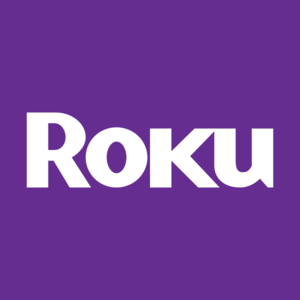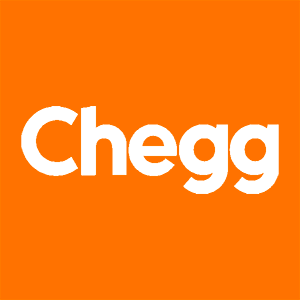
Chegg (CHGG)
We wouldn’t recommend Chegg. Its sales and profitability have plummeted, suggesting it struggled to scale down its costs as demand faded.― StockStory Analyst Team
1. News
2. Summary
Why We Think Chegg Will Underperform
Started as a physical textbook rental service, Chegg (NYSE:CHGG) is now a digital platform addressing student pain points by providing study and academic assistance.
- Annual revenue declines of 16.5% over the last three years indicate problems with its market positioning
- Projected sales decline of 46.4% over the next 12 months indicates demand will continue deteriorating
- Value proposition isn’t resonating strongly as its services subscribers averaged 18.9% drops over the last two years


Chegg doesn’t meet our quality criteria. We believe there are better opportunities elsewhere.
Why There Are Better Opportunities Than Chegg
High Quality
Investable
Underperform
Why There Are Better Opportunities Than Chegg
At $0.91 per share, Chegg trades at 2.3x forward EV/EBITDA. This sure is a cheap multiple, but you get what you pay for.
Cheap stocks can look like great bargains at first glance, but you often get what you pay for. These mediocre businesses often have less earnings power, meaning there is more reliance on a re-rating to generate good returns - an unlikely scenario for low-quality companies.
3. Chegg (CHGG) Research Report: Q3 CY2025 Update
Online study and academic help platform Chegg (NYSE:CHGG) reported Q3 CY2025 results topping the market’s revenue expectations, but sales fell by 43.1% year on year to $77.74 million. On the other hand, next quarter’s revenue guidance of $71 million was less impressive, coming in 13.7% below analysts’ estimates. Its non-GAAP loss of $0 per share was significantly above analysts’ consensus estimates.
Chegg (CHGG) Q3 CY2025 Highlights:
- Revenue: $77.74 million vs analyst estimates of $76.28 million (43.1% year-on-year decline, 1.9% beat)
- Adjusted EPS: $0 vs analyst estimates of -$0.08 (significant beat)
- Adjusted EBITDA: $13.25 million vs analyst estimates of $7.66 million (17% margin, 73% beat)
- Revenue Guidance for Q4 CY2025 is $71 million at the midpoint, below analyst estimates of $82.31 million
- EBITDA guidance for Q4 CY2025 is $10.5 million at the midpoint, below analyst estimates of $10.65 million
- Operating Margin: -22%, up from -163% in the same quarter last year
- Free Cash Flow was -$943,000 compared to -$12.07 million in the previous quarter
- Market Capitalization: $96.51 million
Company Overview
Started as a physical textbook rental service, Chegg (NYSE:CHGG) is now a digital platform addressing student pain points by providing study and academic assistance.
Today, the textbook rental part of the business has been deemphasized, and Chegg Services is the key product. Chegg Services, which is a subscription offering, includes Chegg Study, Chegg Writing, and Chegg Math. Chegg Study allows students to ask questions digitally and receive explanations from subject matter experts. Chegg Writing offers plagiarism detection scans, expert writing feedback, and citation generation. Chegg Math provides step-by-step problem solving so students can get the right answers but also can understand the problem solving process. Tutoring and language learning are emerging areas of focus.
Chegg addresses the high cost of educational resources. Originally, the company offered textbook rentals because the cost of buying, especially for budget-conscious college students, could put a dent in the wallet. From there, the company added subscription services to digitize the business and generate recurring touch points with customers rather than just when textbooks are acquired. The more subjects Chegg adds, the more it becomes a one-stop academic shop.
One growing priority for Chegg is to follow students beyond their educations. The company has begun offering career services such as internship resources and interviewing guides. It has also expanded into financial literacy and other life skills.
4. Consumer Subscription
Consumers today expect goods and services to be hyper-personalized and on demand. Whether it be what music they listen to, what movie they watch, or even finding a date, online consumer businesses are expected to delight their customers with simple user interfaces that magically fulfill demand. Subscription models have further increased usage and stickiness of many online consumer services.
Competitors offering streaming entertainment platforms include Coursera (NYSE:COUR), Udemy (NASDAQ:UDMY), and private company Khan Academy.
5. Revenue Growth
Examining a company’s long-term performance can provide clues about its quality. Even a bad business can shine for one or two quarters, but a top-tier one grows for years. Chegg struggled to consistently generate demand over the last three years as its sales dropped at a 16.5% annual rate. This wasn’t a great result and suggests it’s a lower quality business.
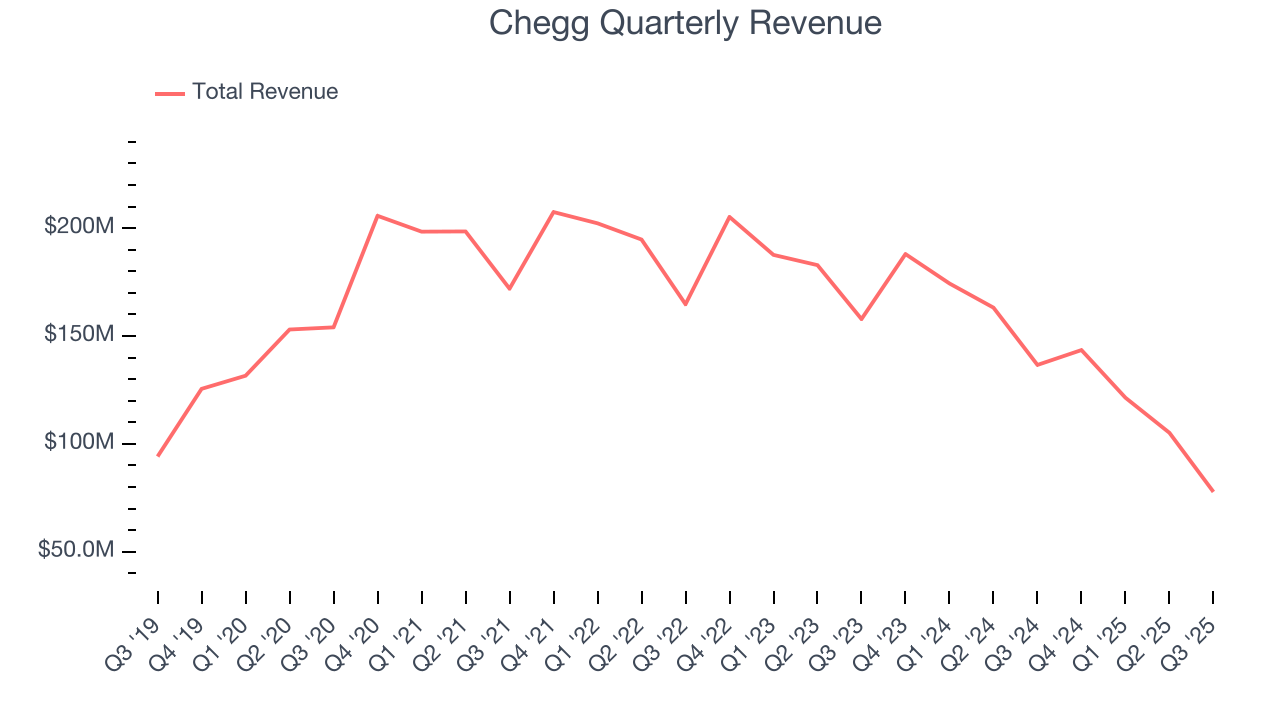
This quarter, Chegg’s revenue fell by 43.1% year on year to $77.74 million but beat Wall Street’s estimates by 1.9%. Company management is currently guiding for a 50.5% year-on-year decline in sales next quarter.
Looking further ahead, sell-side analysts expect revenue to decline by 29.1% over the next 12 months, a deceleration versus the last three years. This projection doesn't excite us and suggests its products and services will face some demand challenges.
6. Gross Margin & Pricing Power
For internet subscription businesses like Chegg, gross profit tells us how much money the company gets to keep after covering the base cost of its products and services, which typically include customer service, data center and infrastructure expenses, royalties, and other content-related costs if the company’s offerings include features such as video or music.
Chegg has robust unit economics, an output of its asset-lite business model and pricing power. Its margin is better than the broader consumer internet industry and enables the company to fund large investments in new products and marketing during periods of rapid growth to achieve higher profits in the future. As you can see below, it averaged an excellent 70.7% gross margin over the last two years. That means Chegg only paid its providers $29.30 for every $100 in revenue. 
This quarter, Chegg’s gross profit margin was 59.2%, down 9 percentage points year on year. Chegg’s full-year margin has also been trending down over the past 12 months, decreasing by 4.9 percentage points. If this move continues, it could suggest a more competitive environment with some pressure to lower prices and higher input costs.
7. User Acquisition Efficiency
Unlike enterprise software that’s typically sold by dedicated sales teams, consumer internet businesses like Chegg grow from a combination of product virality, paid advertisement, and incentives.
Chegg is very efficient at acquiring new users, spending only 25.7% of its gross profit on sales and marketing expenses over the last year. This efficiency indicates that it has a highly differentiated product offering and strong brand reputation, giving Chegg the freedom to invest its resources into new growth initiatives while maintaining optionality. 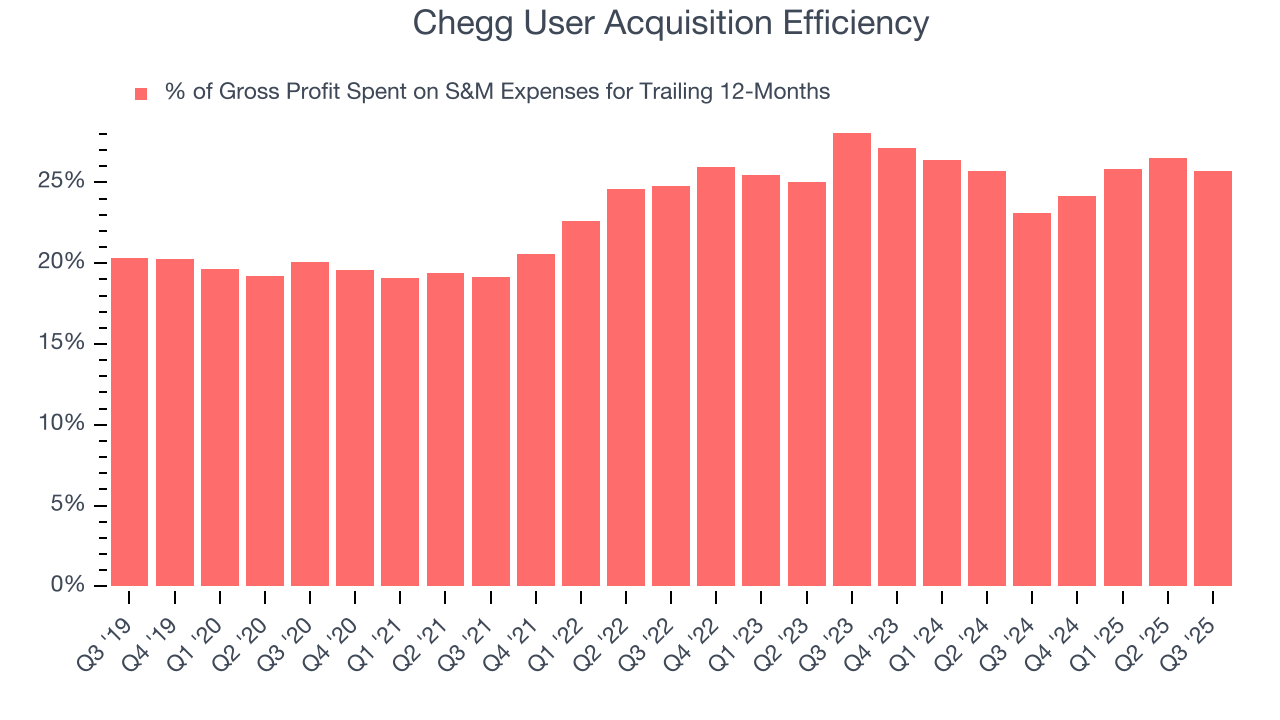
8. EBITDA
EBITDA is a good way of judging operating profitability for consumer internet companies because it excludes various one-time or non-cash expenses (depreciation), providing a more standardized view of the business’s profit potential.
Chegg has been a well-oiled machine over the last two years. It demonstrated elite profitability for a consumer internet business, boasting an average EBITDA margin of 24.5%. This result isn’t surprising as its high gross margin gives it a favorable starting point.
Analyzing the trend in its profitability, Chegg’s EBITDA margin decreased by 13 percentage points over the last few years. Even though its historical margin was healthy, shareholders will want to see Chegg become more profitable in the future.
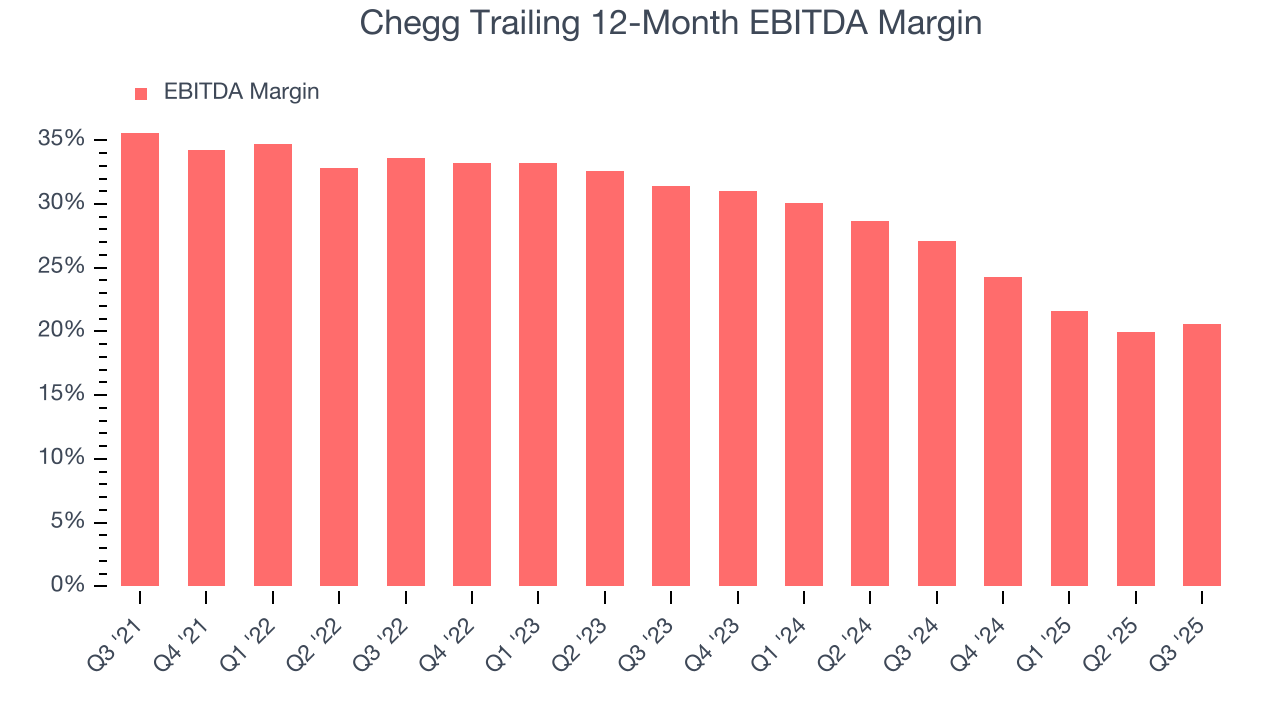
In Q3, Chegg generated an EBITDA margin profit margin of 17%, in line with the same quarter last year. This indicates the company’s cost structure has recently been stable.
9. Earnings Per Share
We track the change in earnings per share (EPS) for the same reason as long-term revenue growth. Compared to revenue, however, EPS highlights whether a company’s growth is profitable.

Diving into the nuances of Chegg’s earnings can give us a better understanding of its performance. As we mentioned earlier, Chegg’s EBITDA margin was flat this quarter but declined by 13 percentage points over the last three years. This was the most relevant factor (aside from the revenue impact) behind its lower earnings; interest expenses and taxes can also affect EPS but don’t tell us as much about a company’s fundamentals.
In Q3, Chegg reported adjusted EPS of $0, down from $0.09 in the same quarter last year. Despite falling year on year, this print easily cleared analysts’ estimates. Over the next 12 months, Wall Street expects Chegg’s full-year EPS of $0.21 to shrink by 67.2%.
10. Cash Is King
Although EBITDA is undoubtedly valuable for assessing company performance, we believe cash is king because you can’t use accounting profits to pay the bills.
Chegg has shown impressive cash profitability, driven by its attractive business model and cost-effective customer acquisition strategy that give it the option to invest in new products and services rather than sales and marketing. The company’s free cash flow margin averaged 9.4% over the last two years, better than the broader consumer internet sector.
Taking a step back, we can see that Chegg’s margin dropped by 16.5 percentage points over the last few years. If its declines continue, it could signal increasing investment needs and capital intensity.
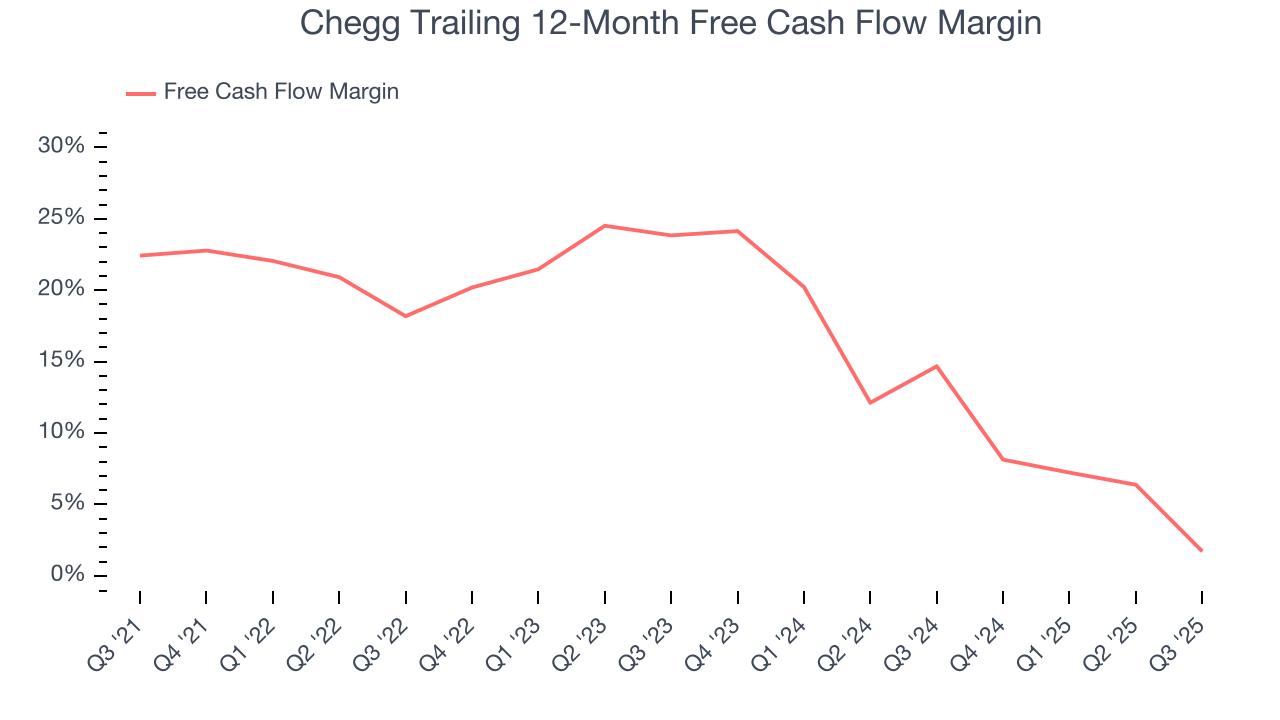
Chegg burned through $943,000 of cash in Q3, equivalent to a negative 1.2% margin. The company’s cash flow turned negative after being positive in the same quarter last year, suggesting its historical struggles have dragged on.
11. Balance Sheet Assessment
Businesses that maintain a cash surplus face reduced bankruptcy risk.
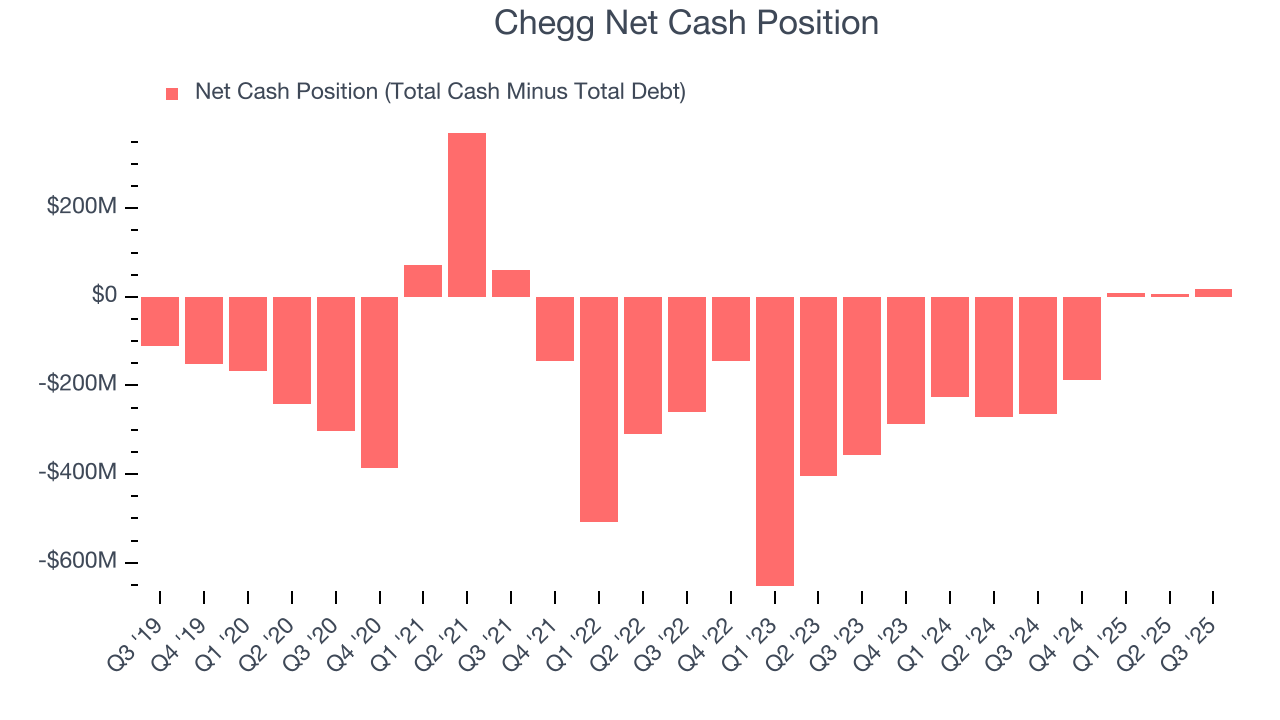
Chegg is a well-capitalized company with $96.39 million of cash and $77.91 million of debt on its balance sheet. This $18.48 million net cash position is 19.1% of its market cap and gives it the freedom to borrow money, return capital to shareholders, or invest in growth initiatives. Leverage is not an issue here.
12. Key Takeaways from Chegg’s Q3 Results
We were impressed by how significantly Chegg blew past analysts’ EBITDA expectations this quarter. We were also happy its revenue outperformed Wall Street’s estimates. On the other hand, its revenue guidance for next quarter missed and its EBITDA guidance for next quarter fell slightly short of Wall Street’s estimates. Overall, this was a softer quarter. The stock traded up 2.3% to $0.91 immediately after reporting.
13. Is Now The Time To Buy Chegg?
Updated: December 24, 2025 at 9:26 PM EST
The latest quarterly earnings matters, sure, but we actually think longer-term fundamentals and valuation matter more. Investors should consider all these pieces before deciding whether or not to invest in Chegg.
We cheer for all companies serving everyday consumers, but in the case of Chegg, we’ll be cheering from the sidelines. First off, its revenue has declined over the last three years, and analysts expect its demand to deteriorate over the next 12 months. And while its impressive EBITDA margins show it has a highly efficient business model, the downside is its users have declined. On top of that, its projected EPS for the next year is lacking.
Chegg’s EV/EBITDA ratio based on the next 12 months is 2.3x. While this valuation is optically cheap, the potential downside is huge given its shaky fundamentals. There are better stocks to buy right now.







